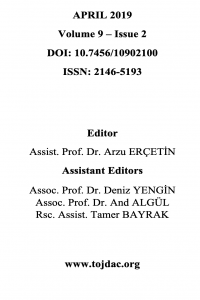Öz
Scientific developments have triggered bleeding-edge technologies that have positive effect on the
life-quality of human-beings. One of these technologies is named as Augmented Reality (AR) which
also the thesis has focused on. The AR technology is defined as the mixture of reality and virtuality.
The AR technology that based on the combination of real space and/or object along with the virtual
object within the same platform, has aimed at getting more information for the interactive users about
the objects interacted with. AR applications can now experience a widespread deployment of mobile
smart devices and a large kit kit. This study aims to discuss the use of a new technique, AR
technology, as a tool in the representation and experience of interior space and the effects of user
experience on the activities of mobile indoor AR applications. For this purpose, we reviewed Android
and IOS-based seven mobile interiors AR applications by searching for 'augmented reality interior
design' on Google Play and Apple Store mobile stores as of February 2018. Therefore, both design and
designers and end users have tried to determine the use of these applications and their identified
deficiencies. In the future, AR is considered to be a powerful influence on the interior designer and
user axis, and is considered as a new technique and strategy that will contribute to the transformation
of the space concept into technology coexistence. The AR technologies, to be deemed as having strong
effect within the framework of interior designer and user, are evaluated as a new technique and
strategy that will make a significant contribution to the transformation of space concept in line with
the developing technologies.
Anahtar Kelimeler
Kaynakça
- Azuma, RT., 1997. A survey of Augmented Reality. Presence: Teleoperators and Virtual Environments, Boston: MIT Press, 6, pp. 355–385. Caarls, J., Jonker, P., Kolstee, Y., Rotteveel, J., Eck, W., 2009. Augmented Reality for Art, Design and Cultural Heritage—System Design and Evaluation, EURASIP Journal on Image and Video Processing20092009:716160 https://doi.org/10.1155/2009/716160. Cowan, P., & Butler, R. (2013). Making geography mobile: using location aware technology to improve student performance in physical geography. Journal of Research and Didactics in Geography, 1(2), 85–105. Craig, A. B., 2013. Understanding Augmented Reality: Concept and Applications, Elsevier Science, USA. FitzGerald, E., Ferguson, R., Adams, A., Gaved, M., Mor, Rhodri, Y., ve T., 2013. Augmented reality and mobile learning: the state of the art. International Journal of Mobile and Blended Learning, 5(4) pp. 43–58. Furth B., 2011. Handbook of Augmented Reality, Springer Science+Business Media Heidelberg , London. Francis, D., Ching, K., 1987. Interior Design Illustrated, USA. Luckin, R., Stanton Fraser, D., 2011. Limitless or pointless? An evaluation of augmented reality technology in the school and home. International Journal of Technology Enhanced Learning, 3(5), 510–524. doi:10.1504/IJTEL.2011.042102. Specht, M., Ternier, S., Greller, W., 2011. Dimensions of Mobile Augmented Reality for Learning: A First Inventory, Journal of the Research Center for Educational Technology (RCET) Vol. 7, No. 1, Spring 2011 RCETJ 7 (1), 117-12. Milgram, P., Takemura H., Utsumi, A., Kishino, F., 1994. Augmented Reality: A Class of Displays on The Reality-Virtuality Continuum, SPIE 2351, Telemanipulator and Telepresence Technologies pp. 282-292, Japan. Munnerley, D., Bacon, M., Wilson, A., Steele, J., Hedberg, J., & Fitzgerald, R., 2012. Confronting an augmented reality. Research in Learning Technology, 20, 1–10. doi:10.3402/rlt.v20i0.19189. Rohs, M., Schöning, J., Krueuger, A., Hecht, B., 2007. Towards Real-Time Markerless Tracking of Magic Lenses on Paper Maps, Adjunct Proceedings of the 5th Intl. Conference on Pervasive Computing (Pervasive), Late Breaking Results, pp. 69–72. Schall, G., 2013. Mobile Augmented Reality for Human Scale Interaction with Geospatial Models The Benefit for Industrial Applications, Springer Gabler. Siltanen, S., Oksman, V., User-Centered Design of Augmented Reality Interior Design Service, 2013. International Journal of Arts & Sciences, 6, 1, pp. 547–563., Finland. Siltanen, S., 2015. Developing Augmented Reality Solutions Through User Involvement, Thesis for the degree of Doctor of Science in Technology, Aalto University School of Science, Department of Computer Science, Finland. INTERNET RESOURCES 1- https://www.gartner.com/smarterwithgartner/top-trends-in-the-gartner-hype-cycle-for-emerging-technologies- 2017/ Date of Access: January/2018 2- https://static2.teknoblog.com/wp-content/uploads/2017/11/amazon-ar-view-021117-1.jpg Date of Access: January/2018 3- http://www.decolabs.com/ Date of Access: January/2018 4- http://www.adrienjeanjean.com/content/decolabs/poster.jpg Date of Access: January/2018 5- http://www.sasachen.com/ikea/ Date of Access: January/2018 6- https://www.intiaro.com/ Date of Access: January/2018 7- http://fingo.pro/en/ Date of Access: January/2018 8- http://developer.viewar.com/site/home Date of Access: January/2018 9- https://www.houzz.com/ Date of Access: February/2018 10- https://www.istaging.com/en/ Date of Access: February/2018
Ayrıntılar
| Birincil Dil | Türkçe |
|---|---|
| Bölüm | Makaleler |
| Yazarlar | |
| Yayımlanma Tarihi | 1 Nisan 2019 |
| Gönderilme Tarihi | 10 Ocak 2019 |
| Kabul Tarihi | 25 Mart 2019 |
| Yayımlandığı Sayı | Yıl 2019 Cilt: 9 Sayı: 2 |
All site content, except where otherwise noted, is licensed under a Creative Common Attribution Licence. (CC-BY-NC 4.0)



